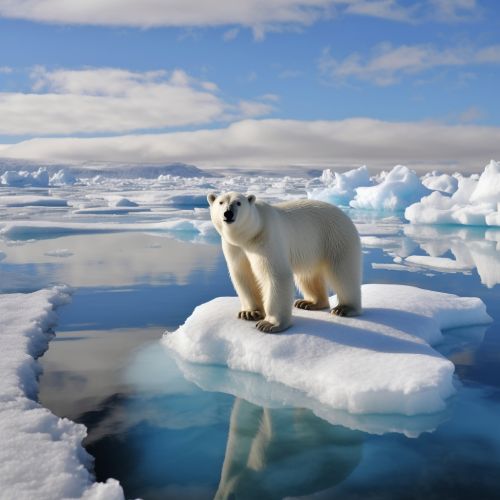Polar Bear
Classification and Evolution
The polar bear (Ursus maritimus) is a hypercarnivorous bear species native to the Arctic regionArctic. It is a member of the bear family (Ursidae), one of the most well-known and widely distributed large carnivore families in the world. The polar bear is classified under the genus Ursus, which also includes the brown bear and the American black bear. The species name maritimus is Latin for "of the sea", referring to the bear's dependence on sea ice and its prowess as a marine predator.


The polar bear is thought to have diverged from the brown bear lineage approximately 500,000 to 600,000 years ago. This divergence was likely driven by changes in climate and the availability of new food sources in the Arctic. The polar bear's adaptations to its harsh environment, such as its white fur, elongated body, and large paddle-like paws, evolved over thousands of years.
Physical Characteristics
Polar bears are distinguished by several unique physical characteristics that enable them to survive in the Arctic. They are the largest species of bear and one of the largest terrestrial carnivores. Adult males typically weigh between 350 and 700 kilograms, while females are approximately half the size of males.
The polar bear's body is elongated and streamlined, an adaptation for efficient swimming. Its fur is thicker and denser than that of other bear species, providing insulation against the cold. The fur appears white, but it is actually translucent, allowing sunlight to reach the bear's black skin, which absorbs heat.
Polar bears have large, paddle-like paws that are well adapted for swimming and walking on ice. Their claws are short and strong, used for catching and holding onto prey. Polar bears also have a keen sense of smell, which they use to locate seals, their primary prey.
Habitat and Distribution
Polar bears are found throughout the Arctic, in areas where they have access to sea ice for most of the year. They are most common in five nations: Canada, Norway (Svalbard), Greenland, Russia, and the United States (Alaska). The total global population is estimated to be between 22,000 and 31,000 individuals.
Sea ice is crucial to polar bears as it provides a platform for hunting seals. They are excellent swimmers and can cover long distances in search of food. However, the ongoing loss of sea ice due to climate change is a major threat to their survival.
Diet and Hunting
Polar bears are apex predators and primarily eat seals, particularly ringed seals and bearded seals. They are patient hunters, often waiting for hours at a seal's breathing hole in the ice. When a seal surfaces to breathe, the bear will reach in and drag it out onto the ice.
Polar bears are also known to scavenge on carcasses of whales and other large marine mammals. In some areas, they have been observed eating vegetation, birds, and eggs, although these make up a small portion of their diet.
Reproduction and Life Cycle
Polar bears have a delayed implantation reproductive strategy. Mating occurs in April and May, but the fertilized egg does not implant in the uterus and begin developing until the fall. If the female has not accumulated enough fat reserves to sustain both herself and her developing cubs, the egg will not implant.
Cubs are born between November and February in a den dug into a snowdrift. They are blind, toothless, and covered in a thin layer of fur. The mother stays with her cubs in the den until they are strong enough to venture outside, usually in March or April.
Polar bears have a lifespan of 15 to 18 years in the wild, although individuals have been known to live into their 30s. They face numerous threats, including hunting, habitat loss due to climate change, and pollution.
Conservation Status
The polar bear is classified as vulnerable by the IUCN. The primary threats to the species are habitat loss due to climate change and pollution. Sea ice loss is particularly concerning as it reduces the bears' hunting grounds and forces them to spend more time on land, where they have less access to their primary food source, seals.
Efforts to conserve the polar bear include international agreements to regulate hunting, habitat protection, and research to better understand the impacts of climate change on the species. However, the future of the polar bear remains uncertain due to the ongoing loss of sea ice.
